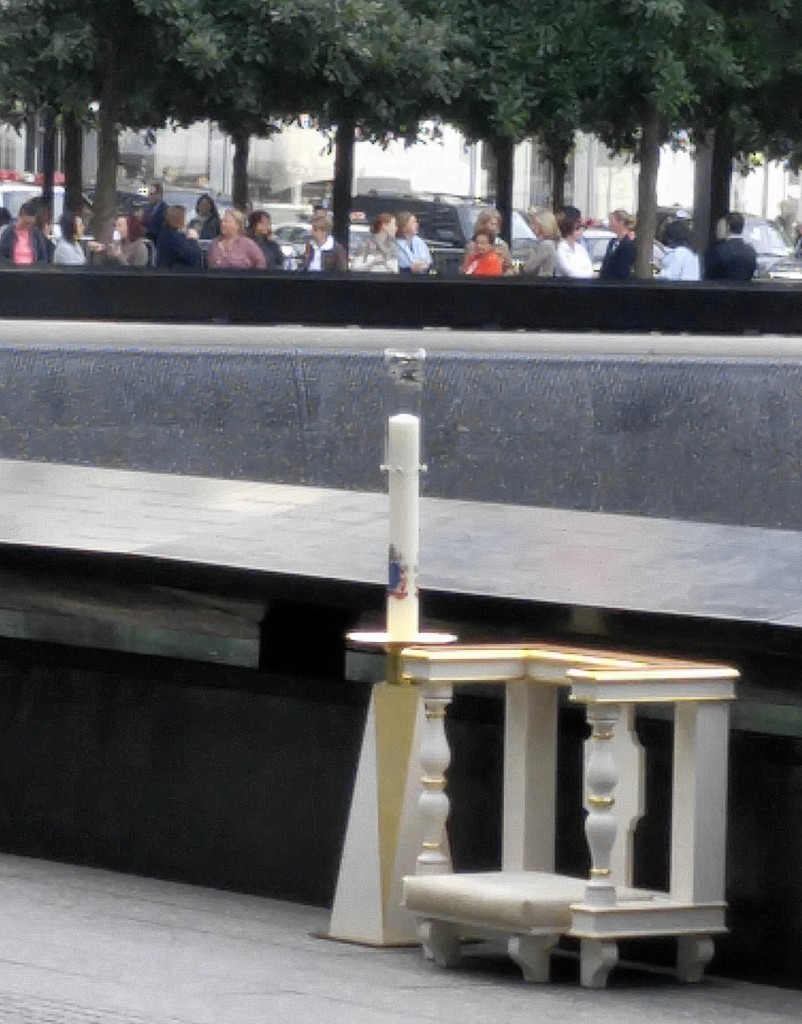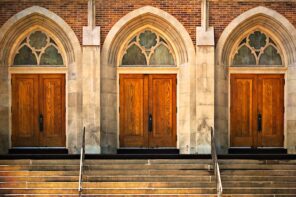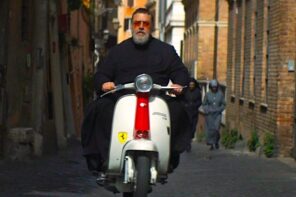On Friday, Pope Francis went for an walk alongside the north pool of the 9/11 Memorial Plaza to meet with ten families who lost loved ones at the twin towers and to participate in an interfaith service with over 600 religious leaders from the New York area.
We have come a long way from 2001, but the hurt and pain remained in the faces of many present, including Tim Rogér of Rochester NY, who lost his daughter Jean, a flight attendant on board American Airlines Flight 11. Mr. Roger said he hoped the pope would say prayers for the place, for the people, and for his daughter Jean.
Praying at a unlighted candle next to the prie-dieu Pope Benedict XVI used on his visit, the Pope offered those prayers silently while looking at the south pool of the memorial.
The 9/11 site has become not just a memorial or a museum—it is a pilgrimage.
For families, it is a place where people lay flowers alongside their loved ones, or walk amongst a  grove of beautiful trees. The roar of the water falling into the two craters left by the towers is a poignant reminder of both that day’s destruction and the endless tears that have flowed since that day. Many bought pictures of loved ones, and the pain in their faces was a reminder that is it never really over for them. For those of us who remember the homemade memorials and pictures of those who were lost in the towers, the museum and memorial grounds are a moving remembrance.
grove of beautiful trees. The roar of the water falling into the two craters left by the towers is a poignant reminder of both that day’s destruction and the endless tears that have flowed since that day. Many bought pictures of loved ones, and the pain in their faces was a reminder that is it never really over for them. For those of us who remember the homemade memorials and pictures of those who were lost in the towers, the museum and memorial grounds are a moving remembrance.
So it was important then, that religious leaders gathered both to see the pope and to participate in an interfaith service of remembrance. It was a mini Parliament of Religions from the New York area, with over 600 interfaith leaders in attendance: Sikhs, Hindus, Buddhists Muslims, and Christians participated, with reflections offered by Rabbi Elliot Cosgrove and Imam Khalid Latif. All were invited to pray with and listen to the pope, who emphasized the importance of dialogue and diversity.
The Pope remarked “In opposing every attempt to create a rigid uniformity, we can and must build unity on the basis of our diversity of languages, cultures and religions, and lift our voices against everything which would stand in the way of such unity.”
The 9/11 Memorial site is the only place in America the Pope worshipped with leaders from other religious groups. His speeches are punctuated with the awareness of the violence and tensions that have arisen from religious fundamentalism.
In his speech to the joint meeting of Congress, the day before the Pope remarked, “no religion is immune from forms of individual delusion or ideological extremism.”.While people will assume that statement was about ISIS, it also describes the current tenor of Islamophobia in America. From the Chapel hill shooting, to GOP presidential candidate Ben Carson, to a Sikh American beaten and called a “terrorist” in Chicago—now more than ever is a time to consider the religious extremism that exists in the American context, not just abroad.
In the words of Mr. Roger, whose daughter Jill was only 24 years old when she died in the 9/11 attack, “I hope that the Memorial will have deep meaning, and will promote peace and welcome.” These days, whether religious or not, we must all share that hope.




